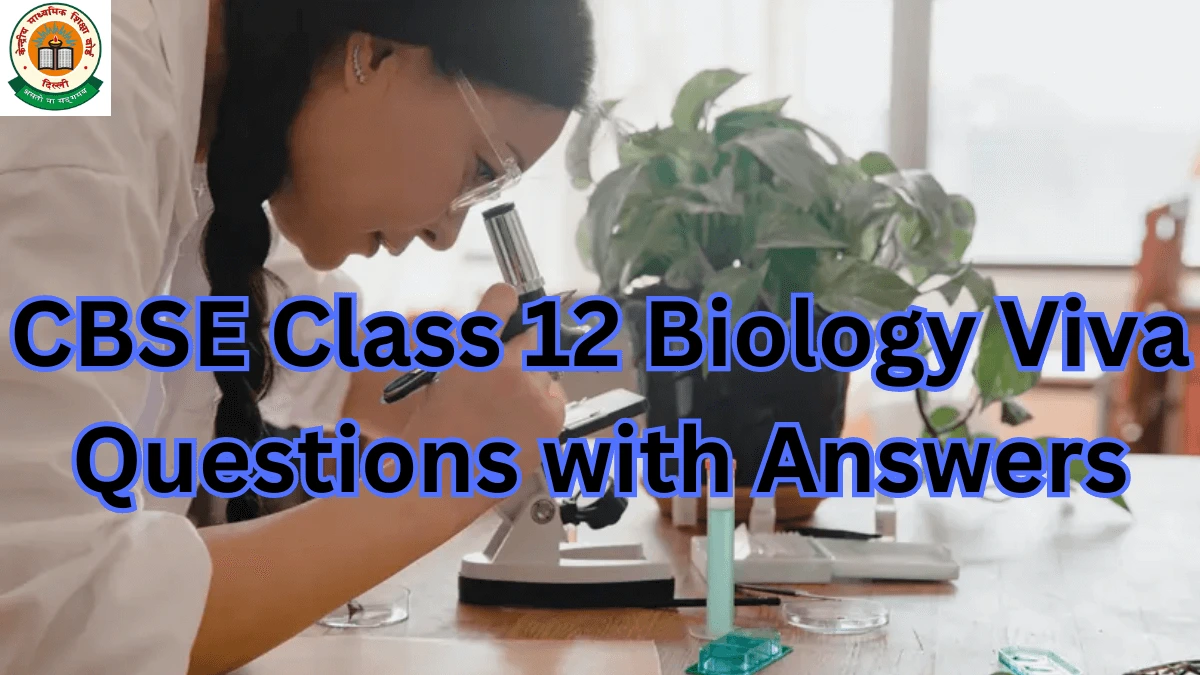The CBSE Class 12 Biology exam is crucial for all the students who are planning to maker their career in the medical domain in the upcoming years. To pursue a successful career in the medical field, students need to have a strong grasp on the subject matter present in class 12th syllabus. To make students robust in the practical domain, we are providing the CBSE Class 12 Biology viva questions with answers in this article for the 2025 practical exam.
CBSE Class 12 Biology Viva Questions
Students in Class 12 should begin reviewing the viva questions in preparation for the Central Board of Secondary Education (CBSE) practical exams, which are about to begin in January 2025. The examiner will look for answers that are clear and succinct rather than ones that are too long. As a result, plan appropriately and refrain from attempting to describe the entire concept. Examine the CBSE Class 12 Biology Viva questions 2025 that are provided below along with their answers. By practicing these viva questions, you will be better prepared and confident for the exam.
CBSE Class 12 Biology Viva Questions with Answers 2025
Students taking the CBSE Biology practical examination in 2025 must prepare the CBSE Class 12 Biology Viva Questions with Answers 2025 shared by our expert teachers here. The viva for the CBSE 12th board exam will be based on the class records and the experiments carried out in the practical exam.
A total of 4 marks out of 30 is assigned to the viva voce and the practical record, while 5 marks are given for the investigatory project and the viva voce performed alongside it. The students must completely understand the experiments and the concepts. This article contains the PDFs with essential CBSE Class 12 Biology Viva Questions and their answers.
CBSE Class 12 Biology Viva Questions 2025 with Answers
The Biology practical exam viva questions for students in Class 12 are listed below. Students can swiftly go through the viva questions given here and review the lessons they have learned this year. Although it won’t take long, it could help you receive a score of 30/30 in the class 12 biology practical exam this year.
Q1. What are the contrasting features that Mendel observed in a pea plant.
Ans: The contrasting features are the colour of the cotyledons, the form of seed, the form of pod, the colour of the seed coat, the length of the stem, the position of the flower, and the colour of the pod.
Q2. Who coined the term mitosis?
Ans: Walther Flemming
Q3. Name two plants and two animals living under aquatic conditions
Ans: Lilly and water hyacinth are aquatic plants. Seals and octopuses are aquatic animals.
Q4. Explain Meiosis.
Ans: Meiosis is a process in which a single cell divides two times to form four haploid daughter cells. Meiosis has 2 stages in all.
Q5. How does the hibiscus flower pollinate?
Ans: The pollen grains in Hibiscus germinates on stamen. It is then transferred from the stamen to the stigma pads of the pistil.
Q6. What is an enzyme?
Ans: An enzyme is a substance which catalyses cell metabolism.
Q7. What is protein? How many kinds of proteins are there?
Ans: Protein is the fundamental component in the living cells. It is made up of hydrogen, carbon, nitrogen, oxygen, and chains of amino acids. Three types of proteins are there which include fibrous, membrane, and globular.
Q8. What is nucleic acid?
Ans: Nucleic acid is a biomolecule which is necessary for all the known forms of life.
Q9. What is a monosaccharide?
Ans: Glucose and fructose are monosaccharides.
Q10. Give a few examples of High Protein Foods?
Ans: Pumpkin seeds, Monkfish, Cod, Coconut, Eggs, Bananas.
Q11. What is the shape of a pollen grain?
Ans: The shape of the pollen grain is mostly round, ovule, triangular, disc or in a bean-shape with a smooth to spiky texture.
Q12. Name 4 types of diseases.
Ans: Deficiency diseases, Infectious diseases, physiological diseases, hereditary diseases.
Q13. What are pollen grains?
Ans: They are small collections of microspores that aid in fertilisation and sexual reproduction in plants. It is attached to the anther of the male reproductive organ of the plant.
Q14. What is somatic cell division?
Ans: Somatic cell division is the type of cell division where the daughter cells produced are exactly similar to the parent cell. They have the same chromosomal number as the parent cell.
Q15. What are enzymes?
Ans: They are substances produced by a living organism which acts as a catalyst to bring about a specific biochemical reaction.
Q16. Give the full form of DNA?
Ans: Deoxyribonucleic acid.
Q17. Why is meiosis known as reduction division?
Ans: Meiosis is also known as reduction division as following the first meiotic division the number of chromosomes in the cell becomes half.
Q18. What is the full form of RNA?
Ans: Ribonucleic acid.
Q19. Name 2 xerophytic plants.
Ans: Ephemeral Annuals and Succulent
Q20. What are Mendel’s laws of inheritance?
Ans: Mendel’s laws of inheritance include the law of segregation, law of dominance, and law of independent assortment.
Q21. Which type of soil is most favourable for the growth of plants?
Ans: Loamy soil is best for plant growth as it has high water retention capacity thus it retains water for long and also retains the nutrients which are required for plant growth.
Q22. What is meant by mitosis?
Ans: It is a type of cell division that results in two daughter cells each having the same number and kind of chromosomes as the parent nucleus, typical of ordinary tissue growth.
Q23. What is the pH of soil?
Ans: The optimal pH range of the soil is between 5.5 to 7.0.
Q24. What is meant by soil texture?
Ans: Soil texture refers to the proportion of sand, silt and clay sized particles that make up the mineral fraction of the soil.
Q25. Pollen is contained in which part of the flower?
Ans: Anther
Q26. What produces the female gamete?
Ans: Ovule
Q27. What is a flower’s male part called?
Ans: Stamen
Q28. What are the various kinds of soil?
Ans: Clay, Loamy, Sandy and Silt.
Q29. Define pollination.
Ans: Pollination is the act of transferring pollen grains from the male anther of a flower to the female stigma.
CBSE Class 12 Biology Practical Questions with Answers PDF 2025
A crucial part of the CBSE Class 12 Biology Syllabus 2025 is the viva. Below are the questions and solutions PDF to the most frequently requested CBSE Class 12 Biology viva questions. These can be used by the students as they get ready for the CBSE Biology practical test viva.










 CBSE Class 12 Physics Sample Paper 2025-...
CBSE Class 12 Physics Sample Paper 2025-...
 MP Board Class 12 Previous Year Question...
MP Board Class 12 Previous Year Question...
 MP Board Class 12th Syllabus 2025-26 Out...
MP Board Class 12th Syllabus 2025-26 Out...

















